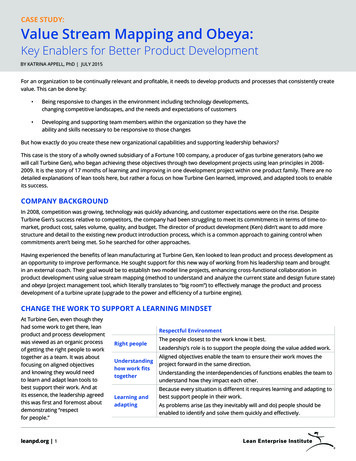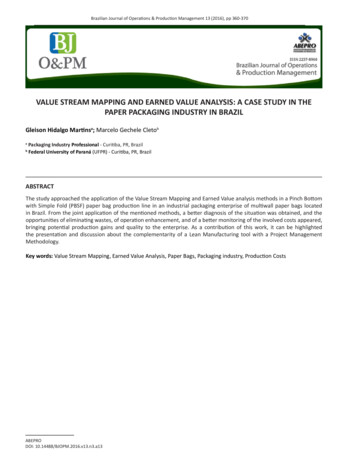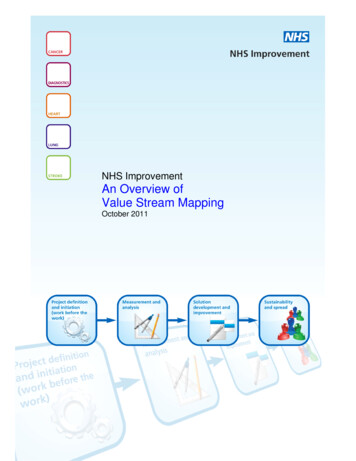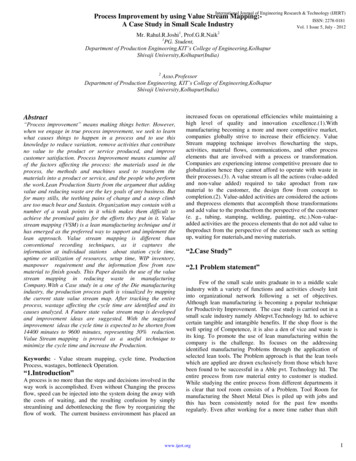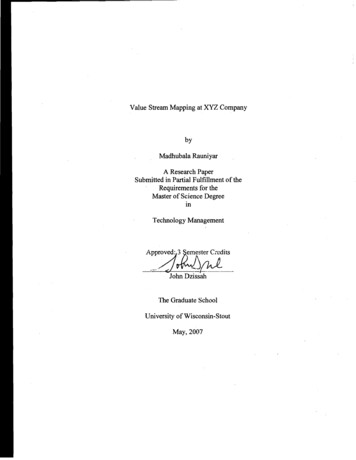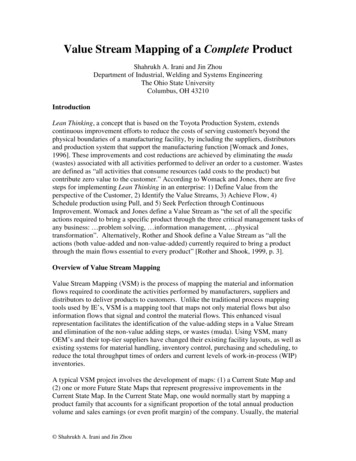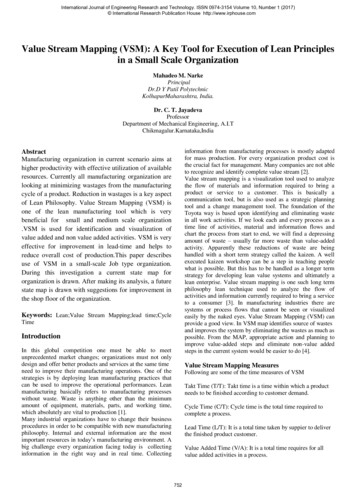
Transcription
Title:Value Stream Mappingfor SMEs: a case studyAuthor:Daan SmitsAcademic Master ThesisRoyal Institute of TechnologyTutor: Professor Thomas Sandberg, KTH7th edition, 2010 – 2012Amsterdam, June 15th, 2012
AbstractDue to a changing competitive environment, SMEs have to improve their productionperformance. A commonly applied philosophy to improve production performance is calledlean thinking. This method, derived from the Toyota Production System, banishes wastefulactivities while increasing the competitive strength and responsiveness of a company.Many companies fail in their attempt to become lean and therefore techniques are needed toguide the implementation. This thesis proposes to use Value Stream Mapping as animplementation technique for SMEs. This technique is tested in a company as a case study.By applying the Value Stream Mapping tool to a specific process within this company,substantial improvement potential is revealed. Work content can be decreased by 30,3percent, and delivery time and in-factory lead time can be decreased by at least 38,6 percentand 68 percent respectively.The thesis concludes that lean thinking is applicable to SMEs, at least under certaincircumstances. Furthermore, Value Stream Mapping can be a valuable tool in revealingimprovement potential.1
Personal Experience and AcknowledgementDuring my studies, two questions regarding lean thinking came up which I have tried toanswer ever since. First, how can an existing organization start to become lean? Second, islean thinking only for large organization, or can it also be applied to smaller companies?Writing this thesis has given me the opportunity to understand more about the combination ofthese two questions. The knowledge and experience I gathered during my academic careercame together in this concluding piece of my studies.Above all, this research allowed me to experience lean ‘in real life’. I have long sought topersonally connect what I learned in the classroom to a practical situation in which humanemotions and behaviors play an important role. From an outsider’s perspective, I was able tosee how employees complain about their managers and how managers complain about theiremployees complaining about them. I saw, and tried to deal with, people who resistedchange even when the quantitative analysis supporting change was overwhelming. On theother hand, I experienced how both managers and employees took genuine steps to reachout to improve the relationship. Where some people were stubborn, others, sometimesunexpectedly, were eager to learn and enthusiastic to change their working habits. On top ofthis all, I finally learned to solder, to connect electric and pneumatic systems, and to use agrinder. At least to some extent. This unique experience already has proven to be veryvaluable in the rest of my career, and will continue to be so in the future.I want to thank Wouter and Maarten for allowing me in their company and for having faith inmy work. André, thank you for showing me around an supporting me along the way. Specialthanks go out to all the employees of Wheels Inc., for being open and honest about theirwork and for answering all my questions. I wish all of you the best for the future.Gratitude to the IMIM consortium, for offering this great opportunity. The past two years havebeen a life changing experience. Thanks to all my amazing friends from around the world. Iwish you well and hope we will meet again and again. Also, I want to thank professorSandberg for guiding me during the past semester.Finally, I want to thank my parents for supporting me in many ways all these years. Withouttheir help and guidance, none of my experiences would have been possible. Thanks to mygirlfriend, for always being there, even at a distance.2
C O N TE N TList of Acronyms . 41.Introduction . 52.Literature Review . 92.1.Lean manufacturing. 92.2.Applicability of lean.162.3.Lean implementation .193.Methodology.233.1.Research strategy .233.2.Value Stream Mapping .273.3.Data gathering.324.Value Stream Mapping applied.344.1.Product Family .344.2.Current State .354.3.Future State .424.4.Implementation.515.Results and Discussion .545.1.Company discussion .545.2.General discussion .566.Conclusion and implications .586.1.Research question .586.2.Generalizability.596.3.Academic relevance .606.4.Managerial implications .607.Limitations and future research .617.1.Limitations .617.2.Future Research .618.Attachments .63A.Observation form .63B.Improvement form (translated) .649.References .653
L I S T O F A C R O N Y MSFIFOFirst In First OutGMGeneral MotorsIMVPInternational Motor Vehicle ProgramJITJust In TimeMRPManufacturing Resources PlanningNNVANecessary Non Value Added(N)NVANecessary Non Value Added and Non Value AddedNUMMINew United Motor Manufacturing, Inc.NVANon Value AddedSMESmall and Medium EnterpriseSMEDSingle Minute Exchange of DiesTOCTheory Of ConstraintsTPSToyota Production SystemVAValue AddedVSMValue Stream Map(ping)WIPWork In Progress4
1. I N T R O D U C TI O NThe current competitive, economic, and global nature of international markets presentscompanies with a changing set of competitive ‘rules of the game’, to which they have toadhere. For ‘Western’ companies, this means that their historically dominant position isthreatened by players from upcoming markets. Especially production companies have feltthis pressure increasing over the past decades. Three trends in particular force Westernproduction companies to improve their competitiveness; globalization, demanding customersand the current economic downturn.GlobalizationThe trend of a globalizing world economy forces Western companies to increase theircompetitiveness. A couple of decades ago, companies mainly competed with competitorsbased in the same region. Decreased costs of intercontinental transport combined with a gapin labor costs between different regions lead to the increased viability of relocating productioncapacity to low cost countries. Not only did Western companies start producing their goodselsewhere, a great number of new competitors, from upcoming countries, entered the globalmarket. The surge of these new competitors clearly shows in, for example, the Fortune 500list. Only a decade ago, USA based companies occupied 185 places on the list, which is nowdown to 133. Similarly, twelve Chinese companies could be found on the list in 2011, versus61 in 2001 (CNNMoney, 2011).An important way for Western countries and companies to compete is to increaseproductivity. In the Western region, the workforce barely grows, making it difficult to increaseoutput by increasing the employee base. This is especially the case in Western Europe,where the workforce is expected to remain stable (Bisson, Stephenson, & Viguerie, 2010).As a result, GDP growth should be generated by improving productivity. More than two thirdsof productivity growth has historically come from product and process innovation. Byincreasing productivity, the labor cost per unit decreases, making the company morecompetitive. As such, the increased competition is a reason for companies to rethink theirmanufacturing processes (Goh, 2006).Demanding customersThe second trend is that customers become more demanding in terms of delivery time andcustomization and that demand for (variations of) products changes rapidly (Stock, Greis, &Kasarda, 1999). Customers expect their products to be delivered faster and faster.Companies could achieve this by keeping stock of products, which can be delivered instantly.However, increasing levels of product customization prevent this strategy from being5
beneficial. Companies would have to keep inventory of such a variety of products, whichgreatly increases holding costs. Holding costs as a percentage of inventory value spans awide range, depending on the industry, but averages between 10 and19 percent, and around40 percent of these costs are accounted for by obsolescence (Timme & Williams-Timme,2003; Wilson & Delaney, 2001).A more attainable and economically viable method to decrease delivery times of highlycustomized products is to decrease the levels of work in progress (WIP). Little’s Law statesthat the time a product spends in a steady state process is linearly correlated to the amountof WIP and the average interval at which products come out of the production process (Little,1961). Decreasing these parameters directly leads to shorter delivery times, which makes acompany more responsive to customer demand. The description of Value Stream Mapping(VSM) (Rother & Shook, 2003) will make clear that it is generally easiest to decrease WIPlevels.Economic downturnThe current economic downturn has a strong negative influence on most world economies. Inthe Netherlands especially the industrial sector encounters negative pressure (Rabobank,2009). The downturn forces companies to decrease costs to cope with decreased demand,and to meet stringent working capital requirements as financial institutions become morestrict. Both can be reached by decreasing WIP levels. First, lower WIP levels leads to lessrequired working capital, since working capital equals current assets minus current liabilities,and WIP is considered to be a current asset. Second, a lower level of WIP decreases costsas this leads to lower holding costs, as described earlier.Effects on Small and Medium EnterprisesThese trends also affect an important group of companies, Small and Medium Enterprises(SMEs). SMEs are defined as companies with less than 250 employees, and less than 50million of revenue or a balance sheet total less than 43 million. This group of companiesrepresents an important part of the European economy. 99 percent of businesses in theEuropean Union are SMEs, over two thirds of private sector jobs are found SMEs, and SMEsaccount for more than half of the value added in the European Union (EuropeanCommission, 2012).Research shows that SMEs are strongly affected by the economic situation (Dun &Bradstreet, 2011). SMEs have relatively little negotiating power with their customers andsuppliers concerning payment conditions in order to improve working capital levels andprices (Manoochehri, 1988; Porter, 1979). Their problems with working capital lead to6
financing issues, since they have little negotiating power with their lenders (especially banks)and banks are currently not keen on increasing credit facilities for companies.The combination of the three described trends and the large effects these trends have onSMEs, leads to the conclusion that SMEs need to improve their processes in order tosurvive. This is especially relevant for the European economy, due to the important fractionof businesses, jobs, and added value SMEs are responsible for.Improving production processesA popular method for large companies to improve production processes is to engage inimplementing the Lean production philosophy (Hopp & Spearman, 2008). This methodology,derived from the Toyota Production System, focuses on eliminating wasteful activities,categorized in seven types of waste: Transportation, Inventory, Movement, Waiting, Overprocessing, Over-production and Defects. Literature on lean manufacturing presents tools toidentify these wastes as well as countermeasures to deal with the wastes. Research showsthat the implementation of lean manufacturing can lead to significant improvements in overallperformance indicators, such as productivity, quality and delivery lead time (Zimmer, 2000).This concept was developed in Japan after the Second World War, because at that time,Japanese manufacturers did not have the possibility to make the large investments neededto compete with manufacturers based in the United States. Their competitive advantage thusneeded to be based on increasing productivity with lower investments.The road to becoming lean can be full of obstacles and many companies fail in their attempt(Sohal & Egglestone, 1994). This is described in abundant research, especially concerninglarge companies. The implementation of lean in SMEs received less attention in theacademic literature. As this philosophy may yield positive results in large companies, it isinteresting to understand if it is applicable to SMEs to a similar extent and this will be thefocus of this thesis.This thesis proposes to use a technique, called Value Stream Mapping (VSM), as a startingpoint for SMEs to become more lean, and thus more productive and competitive. The VSMtechnique first describes the entire process of the becoming of a specific product (family).Through a series of questions, the technique then guides towards a proposed future state. Inthe future state less time should be spent on activities which do not add value to the product.This technique has a number of favorable characteristics to apply it as an implementationmethod. First, it is a well tested and relatively simple technique. Furthermore, VSM presentsits findings in comprehensive, visual representations of a value chain. This is key in theinvolvement of higher management. Finally, it gives an indication of what lean tools areapplicable for the specific process of the company. This final advantage is of great7
importance, because lean manufacturing offers a vast variety of tools and companies haveproblems to identify exactly what tools are needed and how they should be implemented(Pavnaskar, Gershenson, & Jambekar, 2003).The purpose of this thesis is to understand if VSM is indeed a useful method for SMEs tobecome more productive and to serve their customer better. Subsequently, the researchquestion is:Does Value Stream Mapping offer a valuable guidance in the quest of SMEs to becomemore productive and to increase responsiveness to customer demand?The sub research questions comprising the main research question are:(a) Is the lean manufacturing philosophy applicable to SMEs?(b) Is VSM the most appropriate tool to initiate lean in SMEs?(c) Does VSM reveal sufficient improvement potential for SMEs?Sub research questions A and B will primarily be investigated by means of an extensiveliterature review. The methodology section of this thesis will describe the approach to subresearch question C.Delimitations of this researchThis thesis will focus on companies classified as discontinuous flow line manufacturingsystems, derived from the framework of Hayes and Wheelwright (1979). According to Lasa,de Castro, and Laburu (2009), a great portion of lean research focuses on these companies.They also state that lean tools have shown great impact in this type of companies andtherefore this thesis will limit to the lean philosophy. Other productivity improvementmethods, such as Theory of Constraints (TOC) (Goldratt & Cox, 1984) or Total QualityManagement are outside the scope of this thesis. As the lean philosophy is primarilyassociated with manufacturing, this thesis will focus on manufacturing elements. Finally, thisthesis will focus on companies with productivity and lead time concerns, since lean wasoriginally intended to tackle such problems (Ohno, 1988).8
2. L I TE R A T U R E R E V I EWIn this literature review first the history of lean manufacturing, its most commonly used tools,and the results which can be achieved by implementing lean will be elaborated upon. Then,the applicability of lean manufacturing in different fields and types of companies will bediscussed. Finally, the methods of implementing lean manufacturing are covered whichresults in the hypotheses of this research.2.1.L E A N MA N U F A C T U R I N GThis section will give an overview of the history of Lean and the Toyota Production System(TPS), its most prominent tools and finally the results which can be achieved throughimplementing lean thinking.HistoryAfter the second World War Japan suffered from high costs of raw materials due to a lack ofresources. This made Japanese companies less competitive on the global market. Toyotarecognized that in order to compete, they needed to “( ) produce better quality goodshaving higher added value and at an even lower production cost than those of the othercountries” (Sugimori, Kusunoki, Cho, & Uchikawa, 1977, p. 553). Normally, this would call forthe implementation of mass production techniques, which dominated the industry at the time.Eiji Toyoda, head of the Toyota Company at the time, was indeed determined to become amass producer. This would require acquiring expensive production means which werespecialized at producing large batch sizes of products. These large batches were necessaryto spread the large investment over enough products, and to deal with lengthy setup times.However, the relatively small home market of Japan, combined with capital constraints,initially prevented Toyota from setting up such a mass production facility (Holweg, 2007).Apart from financial and economic restrictions, Toyoda also recognized some major,structural flaws in the mass production methodology. To be competitive, mass producers aimto benefit from economies of scale. To reduce unit setup and machine costs, they generallyproduce in large batches of identical products which work their way through the productionfacility. As a result, “( ) parts spend most of their time waiting in queues rather than in beingactually processed” (Karmarkar, 1987, p. 410). In concurrence with Little’s Law, this results inlonger lead times.This ‘batch and queue’ method is problematic for a number of reasons. By elongating thetime period between fabrication of a part and its use in a following process step increases the9
risk of loss or deterioration while it also increases the time between fabrication and possiblefeedback about quality. Furthermore, the level of safety stocks grows more thanproportionally with lead times, since the safety stocks have to protect against longer leadtimes as well as greater variability in forecasts due to a longer prediction horizon. Finally,long lead times decrease a company’s competitiveness due to distant due dates and makecompanies less responsive to customer demand (Karmarkar, 1987). Indirectly, the batch andqueue method makes the producer incapable of delivering the product diversity demandedby consumers (Holweg, 2007).Toyota recognized what they had to do: make low cost, low waste, high value products bycombining different production techniques into a system which would produce a wide mix ofproducts with low volume per product variety. An important person in the quest of Toyota toreach this was Taiichi Ohno, who joined Toyoda Spinning and Weaving in 1932 (Holweg,2007). To decrease cost, Toyota put a severe focus on the elimination of waste, which is“( ) anything other than the minimum amount of equipment, materials, parts, and workers(working time) which are absolutely essential to production are merely surplus that onlyraises the cost” (Sugimori et al., 1977, p. 554). High quality should be attained by decreasingbatch size, since Ohno had recognized that large batches, amongst having other effects,resulted in high number of defects (Holweg, 2007).Over a span of several decades, starting in the 1950s, Toyota slowly developed itsproduction system. According to Fujimoto (1999), the production managers at Toyota (suchas Kiichiro Toyoda, Taiichi Ohno, and Eiji Toyoda) combined elements of a mass productionsystem with their own ideas. Some believe that Toyota ‘invented’ a new production method,but actually it took some decades to become the Toyota Production System (TPS) as itbecame known to the rest of the world (Holweg, 2007).It might sound trivial that the ‘secret’ of Toyota is eliminating all the process steps which donot add value, but studying the Toyota Production System more closely reveals someinsights about how fundamentally different it is from traditional manufacturing views. Allworkers in Toyota factories are allowed to stop the line they are working on if they find adefect, by pulling a cord next to their working station. Also, every employee at Toyota has theright, and is encouraged, to make improvements to the production process (Sugimori et al.,1977). This is different from traditional plants, where special teams implement improvementsand where extensive quality controls check for defects at the end of the line. All employees atToyota learn to make improvements according to the so called Scientific Method. Whenemployees see a problem, they try find the root cause and a countermeasure which copeswith this cause. Before they implement the countermeasure they make an hypothesis about10
the effect of the countermeasure. Finally, they compare the actual to the predicted effect andinvestigate the possible difference. As such, they aim to truly understand not only theproblem, but also the solution (Spear, 2004). The hypothesis based improvement processmakes it ‘scientific’.Understanding the Toyota Production SystemTPS was first not understood by Western companies and academics and the superiority ofTPS was sometimes bluntly negated. Holweg (2007) gives a clear insight in the developmentof understanding Toyota’s production methods and this will be elaborated upon next.The first barrier to understand TPS was that it was not documented before 1965, when it wascommunicated, in Japanese, to Toyota’s supplier network. At this point, Toyota had alreadystarted a steady increase in market share. During the 1970s concerns amongst Westernproducers about Japanese imports rose. In 1980, 22,2 percent of personal cars sold in theUnited States came from Japan. Trade agreements were instituted to restrict the number ofimported cars. Toyota worked around these restrictions by setting up assembly plants in theUnited States.It was clear that Toyota had some competitive advantage, but at first this was attributed toexternal factors in favor of Toyota. Explanations varied from favorable wages and exchangerates, to support of the Japanese government and cultural differences. These explanationswere eagerly supported by industry representatives, but some researchers, such asAbernathy, Clark, and Kantrow (1981), understood that the competitive advantage wasmostly explained by superior manufacturing practices. In 1985 the International MotorVehicle Program (IMVP) started to investigate why Japanese companies were outplayingWestern companies and how large the gap was. The IMVP was a research program focusedon the automobile industry, consisting of researchers from all over the world, based at theMassachusetts Institute of Technology.A major breakthrough in accepting the superiority of TPS was instigated by a collaborationbetween Toyota and General Motors (GM), called the New United Motor Manufacturing(NUMMI) joint venture. In this joint venture, initiated in 1984, Toyota and GM reopened aformer GM plant to produce cars of both brands. After the first year, the productivity at theNUMMI plant was more than 50 percent higher than the productivity level at another GMplant which was technologically similar. Also, the NUMMI plant had the highest qualitystandards of all GM’s U.S. plants. Under Toyota's leadership, labor input per vehicle wasreduced to 19 hours, down from 36 hours previously. Defects dropped from 1,5 to 0,5 per100 vehicles, and absenteeism decreased from 15 percent to 1,5 percent. NUMMI achievedthese results without great changes in used technology and by hiring mostly the same11
workforce of when the plant closed in 1982 (Krafcik, 1986). This convinced the industrialsponsors involved in IMVP, of the fact that Toyota’s true advantage did not lay in factorssuch as culture, but in its production philosophy.From TPS to LeanJohn Krafcik, one of the academics working for IMVP, was the first to use the term ‘leanproduction’ (Krafcik, 1988b). ‘Lean production’ is a more generic term for the principlesinstituted in TPS. According to Liker (1997, p. 481) lean is “(.) a philosophy that whenimplemented reduces the time from customer order to delivery by eliminating sources ofwaste in the production flow”. Elliot (2001) states that the three basic principles of the leanphilosophy are flow, harmony (pace set by customer demand), and synchronization (pullflow). He argues that these three principles should be present throughout the entireorganization. Numerous authors, such as Turfa (2003) and Vasilash (2000), emphasize thatlean manufacturing is not a tactic, but should be viewed as an endless journey a companyembarks on. Finally, Ohno (1988) remarks that apart from the critical focus on eliminatingwaste, respect for humanity was equally important.Lean and TPS are similar, but not the same. According to Hall (2004) key differencesbetween lean and TPS are in the focus at the start of the process, the source of the solutionsand the level of standardization. TPS usually starts with optimizing each separate (sub)process to achieve (close to) zero defects and therefore takes a detailed perspective in thebeginning, before optimally linking the steps together. Lean starts with a broader view,looking at the entire process and identifying main sources of waste, which often occur at theboundaries of processes. Lean generally focuses on the implementation of tools, comingfrom a predetermined set of tools, to eliminate waste. These implementations are more likelyto be driven by staff, which prevents employees to increase their problem solving skills. TPSfocuses strongly on employee skills and allows countermeasures to problems to evolve moreorganically. Finally, it seems that TPS emphasizes more strictly on the standardization anddocumentation of work methods. This allows them to continuously ‘test’ if the work methodsare adequate or can be improved.Lean ToolsAround 101 different tools mentioned in the academic literature can be identified (Pavnaskaret al., 2003). Based on works of different authors, such as Shah and Ward (2003), Detty andYingling (2000), and Bhasin and Burcher (2006), a selection of most common tools wasmade to be discussed here.12
5SThis method aims to improve work area efficiency by strictly selecting what material isessential at a certain workstations. This material is given a specific location close to where itis required. Non-essential materials are placed on less prominent locations. In the translatedversion, the five ‘S’s stand for Sort, Straighten, Shine, Standardize, and Sustain. The 5Smethodology is aptly summarized by the following statement: "A place for everything andeverything in its place" (author unknown) (cited in Mastroianni & Abdelhamid, 2003).KaizenKaizen is the Japanese expression for “improve for the better”. It is the daily effort toconstantly improve the process of a company. Origins of wasteful activities are identified andsought to be eliminated. On top of the daily effort, special Kaizen events, called Kaikakuevents (Womack & Jones, 2003), can lead to more breakthrough improvements. In suchevents, a specific process is studied in great detail to achieve more substantial improvement.Just-in-Time (JIT)By producing products and parts ‘just in time’ it is
guide the implementation. This thesis proposes to use Value Stream Mapping as an implementation technique for SMEs. This technique is tested in a company as a case study. By applying the Value Stream Mapping tool to a specific process within thi
